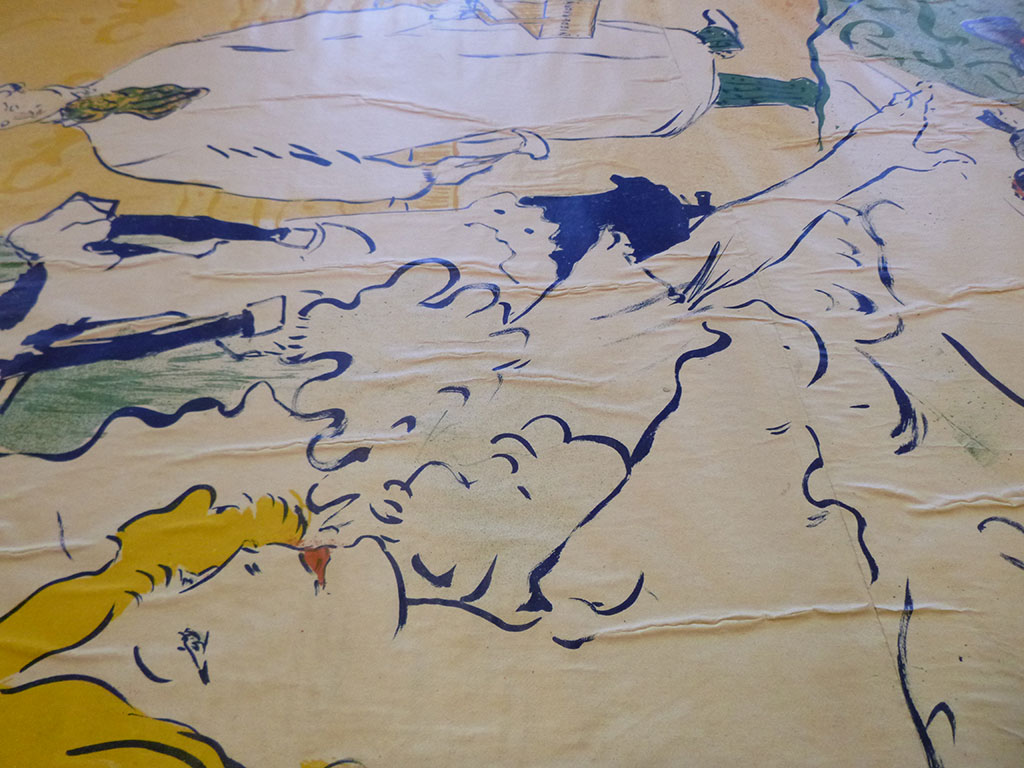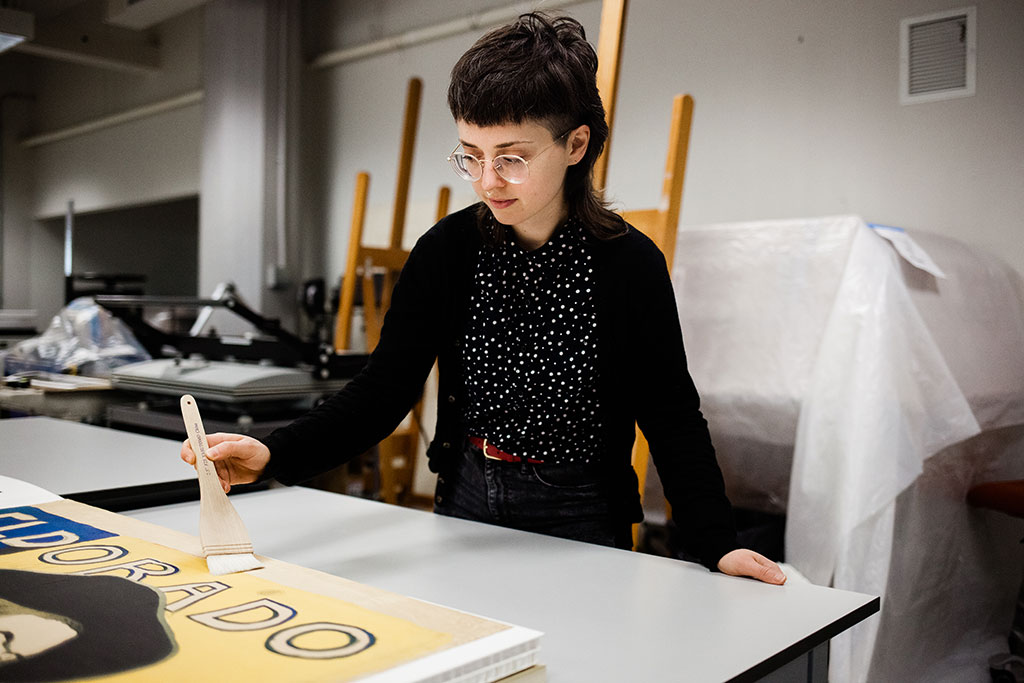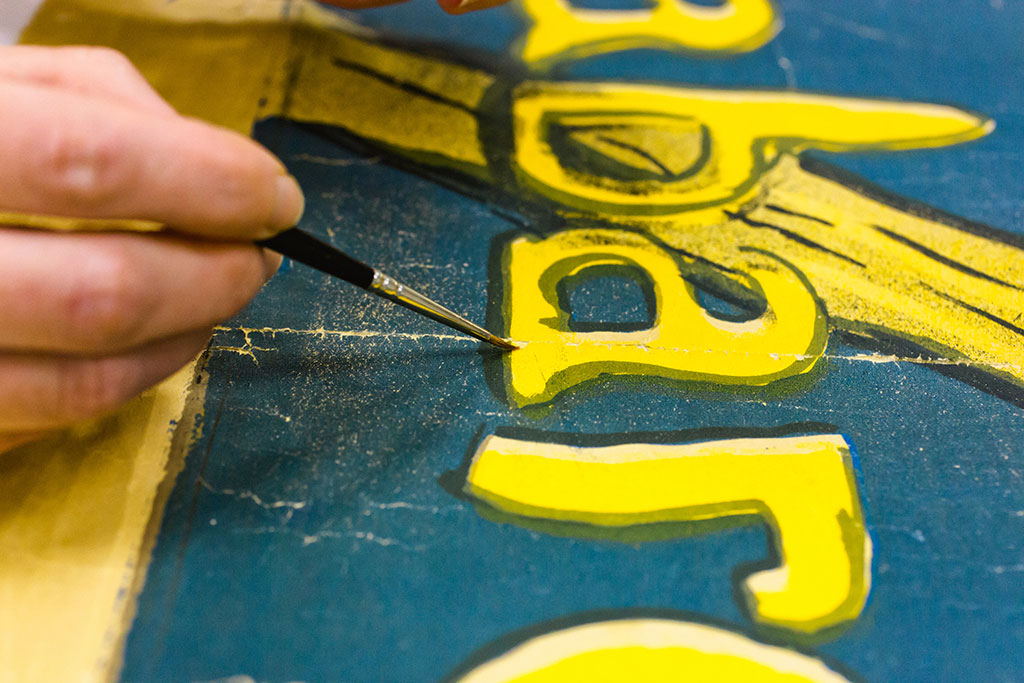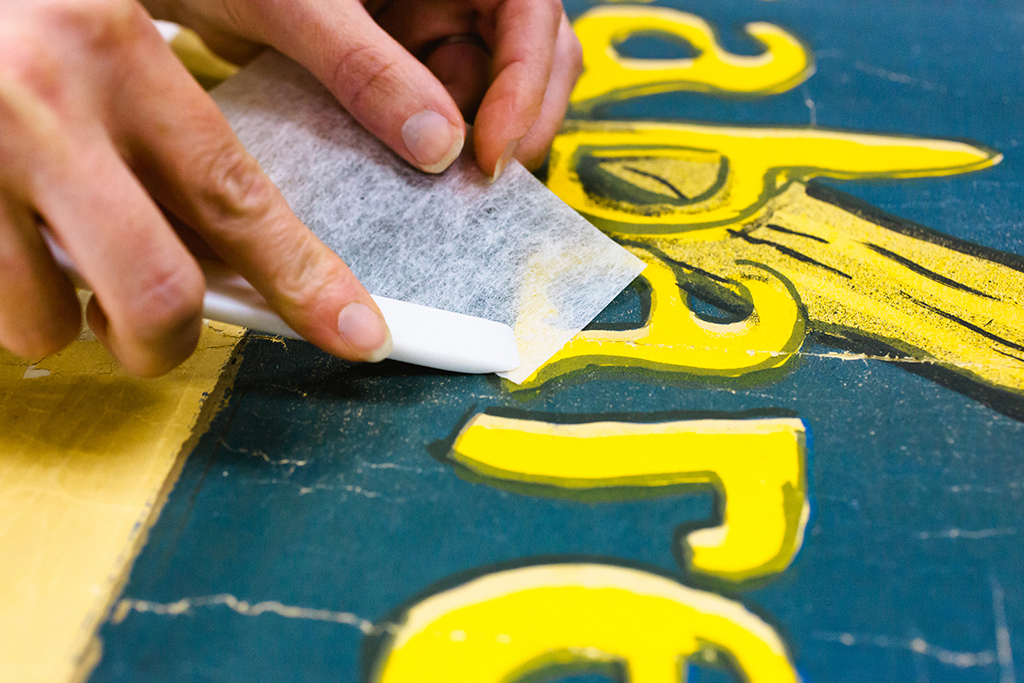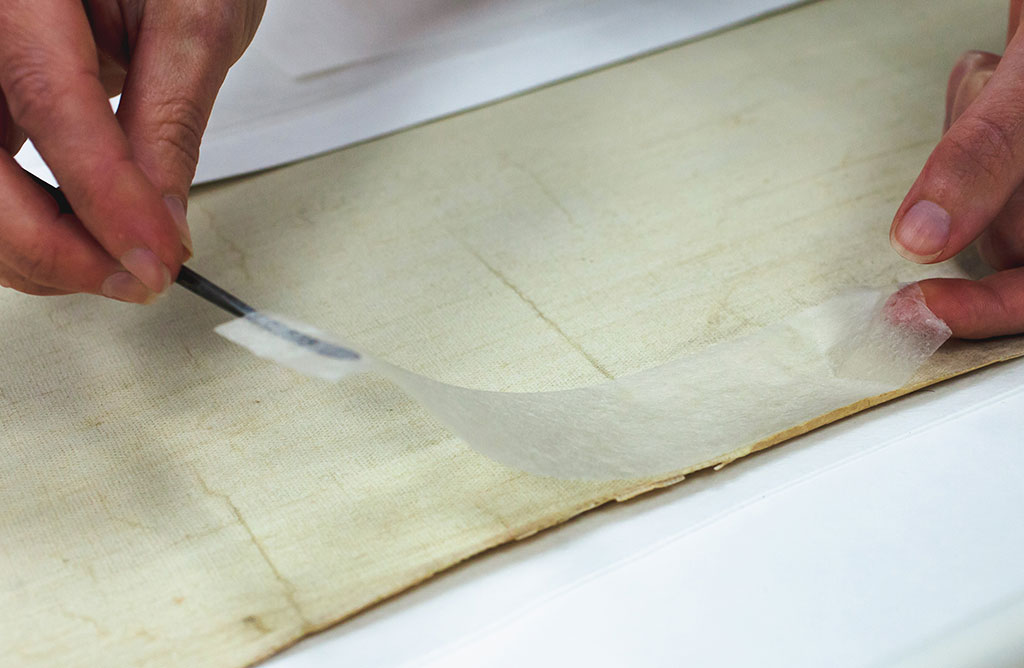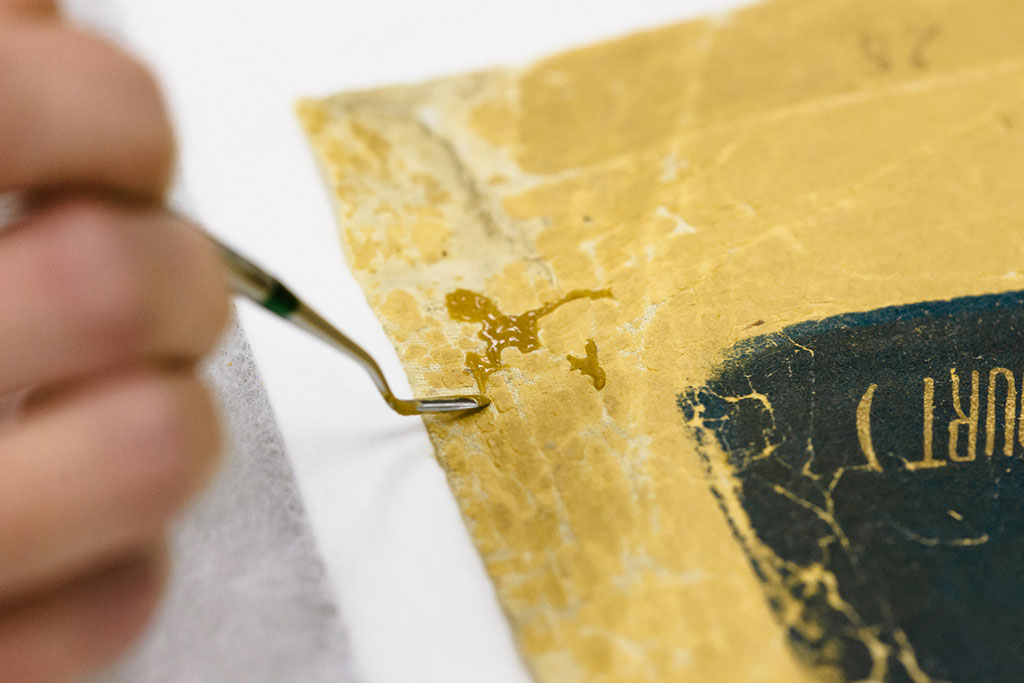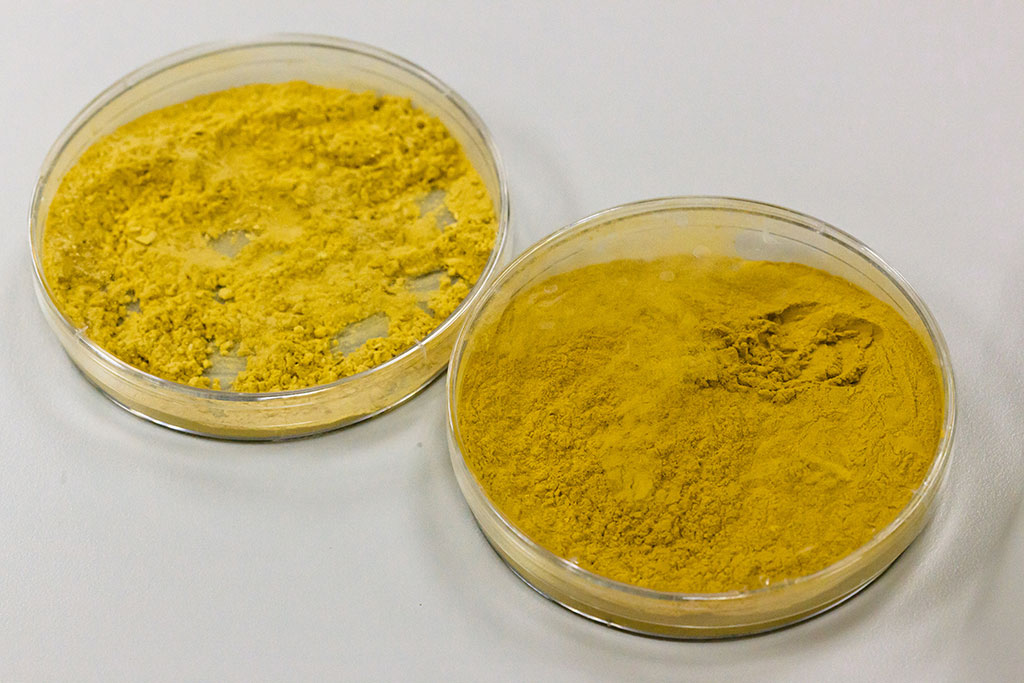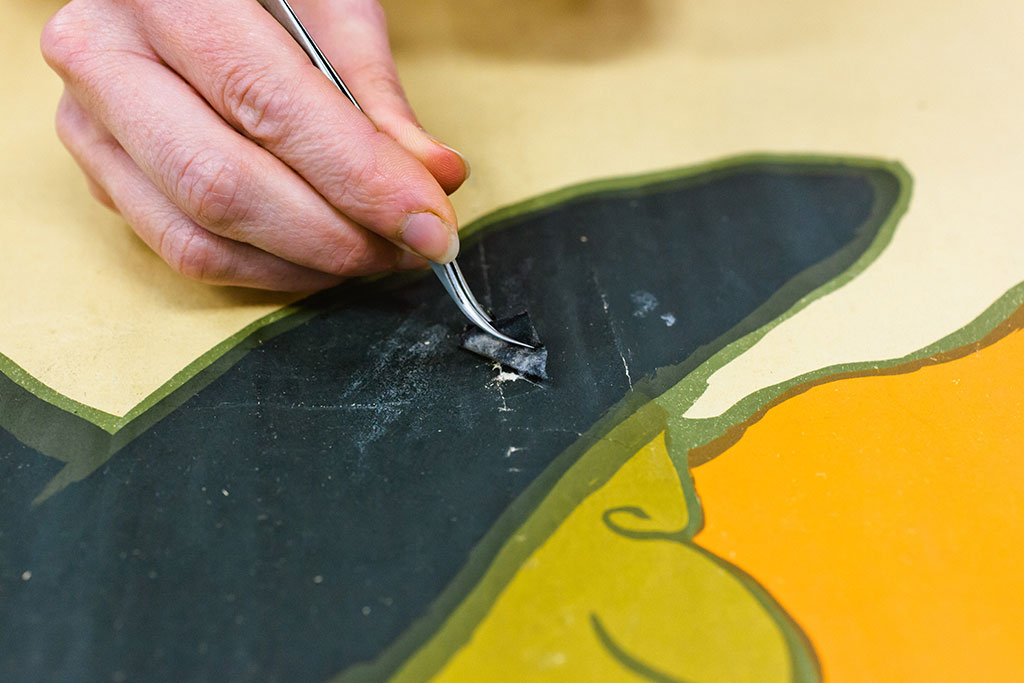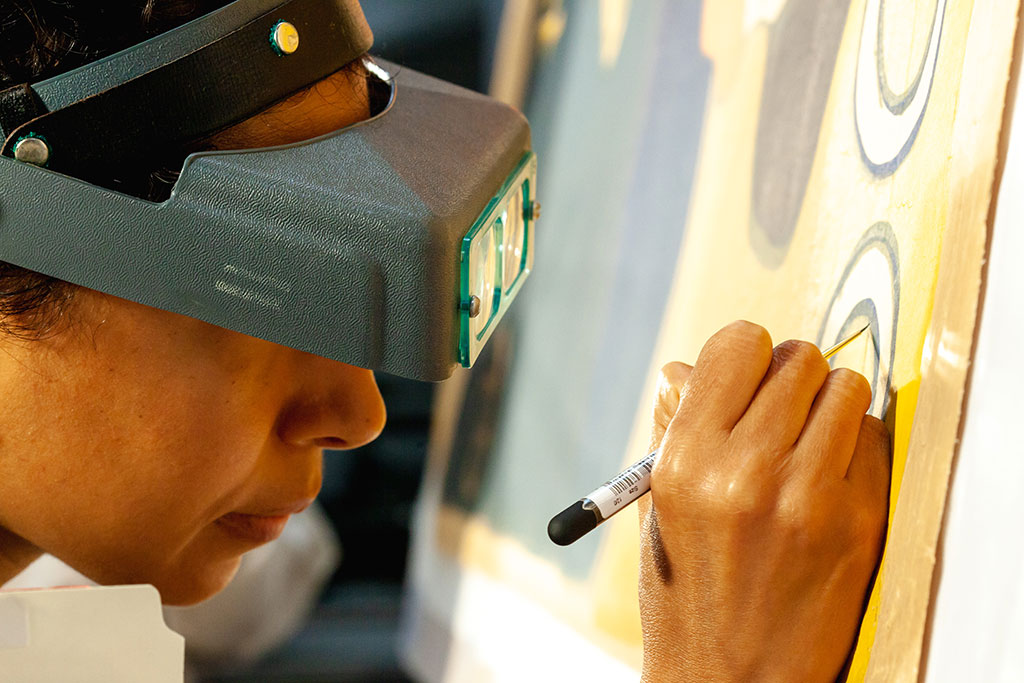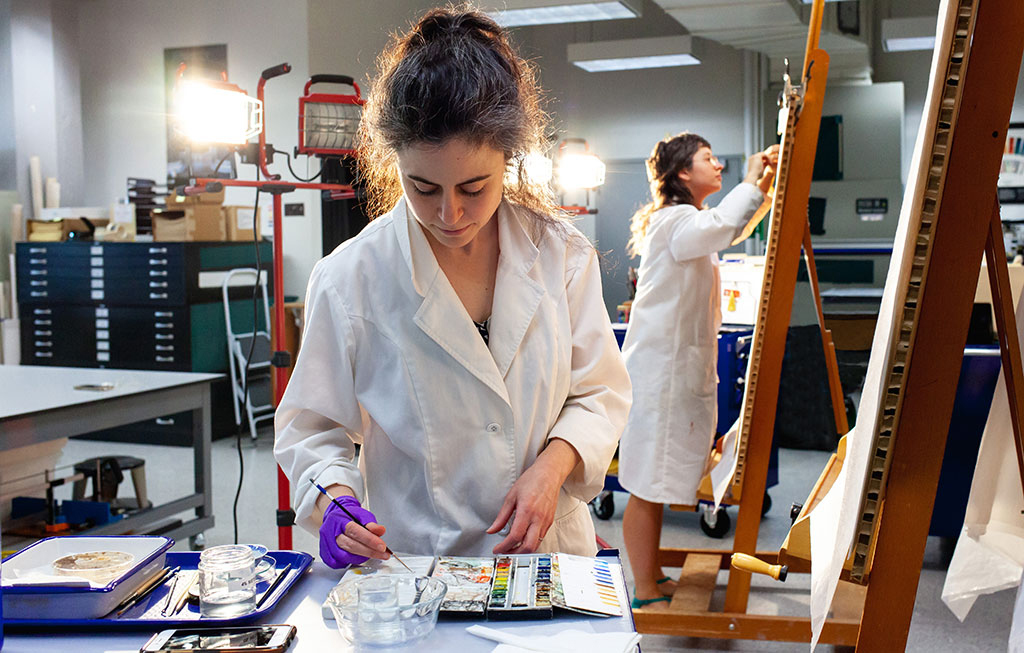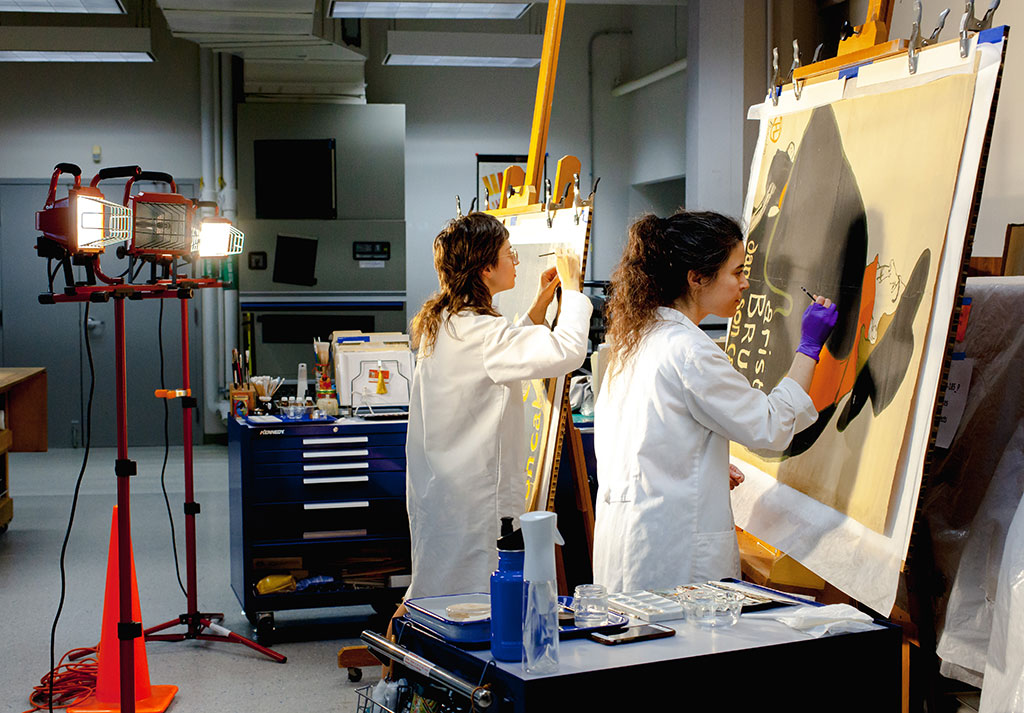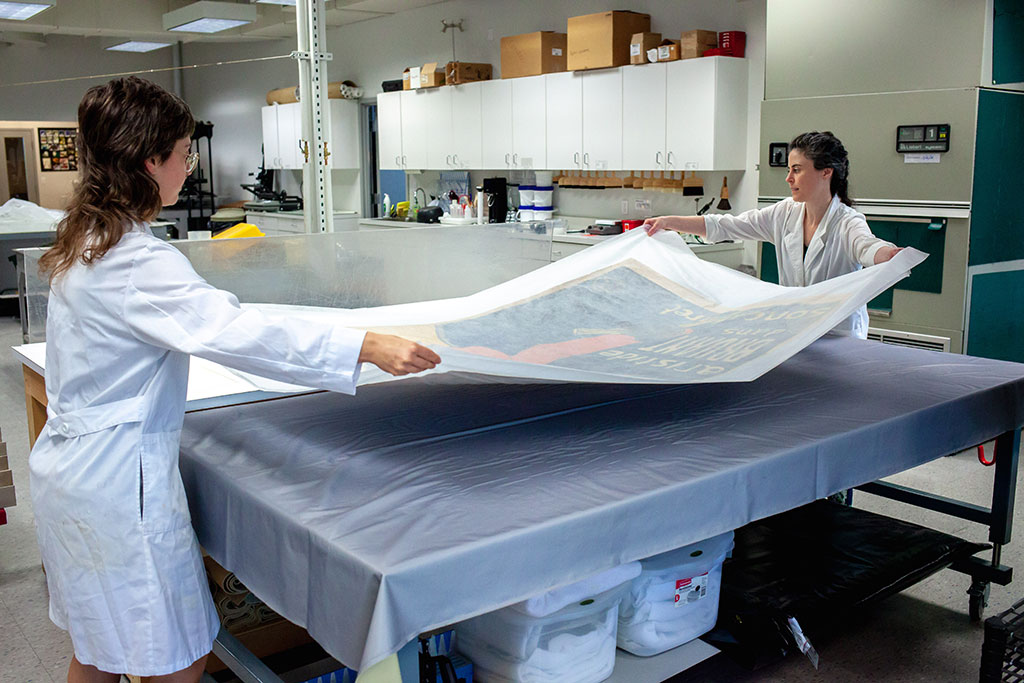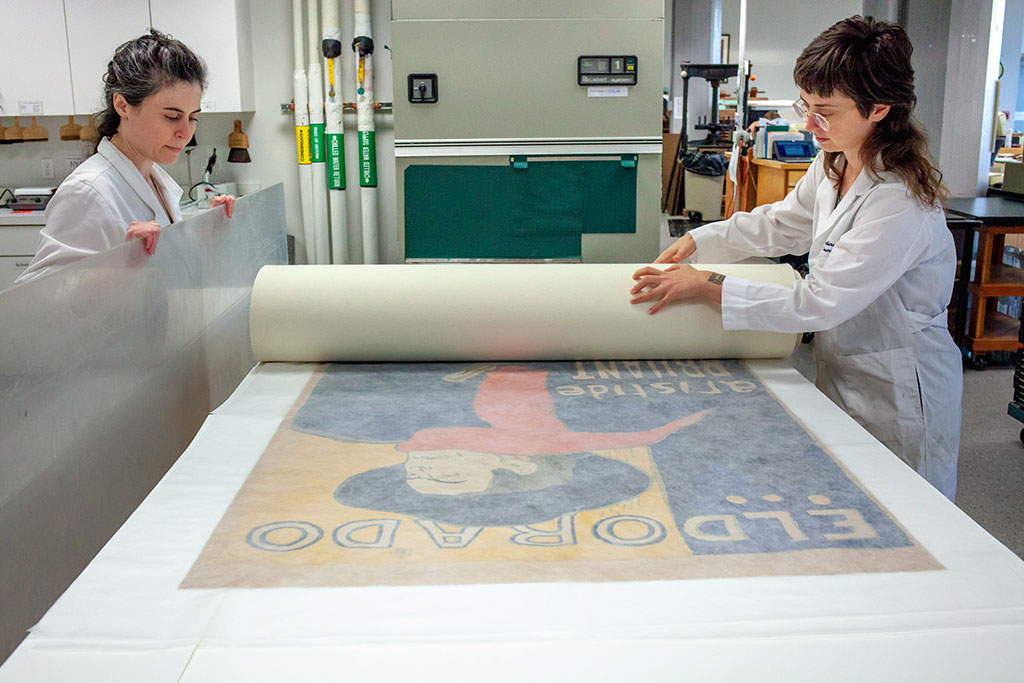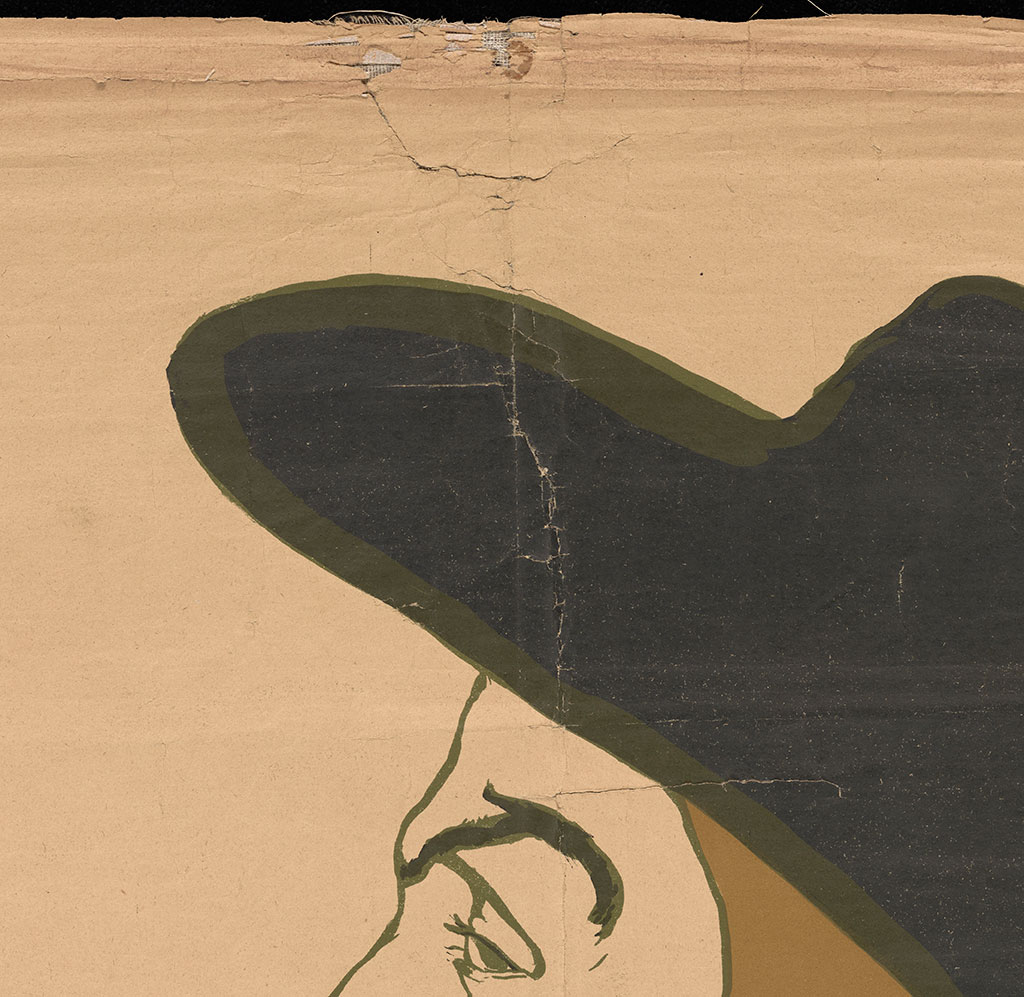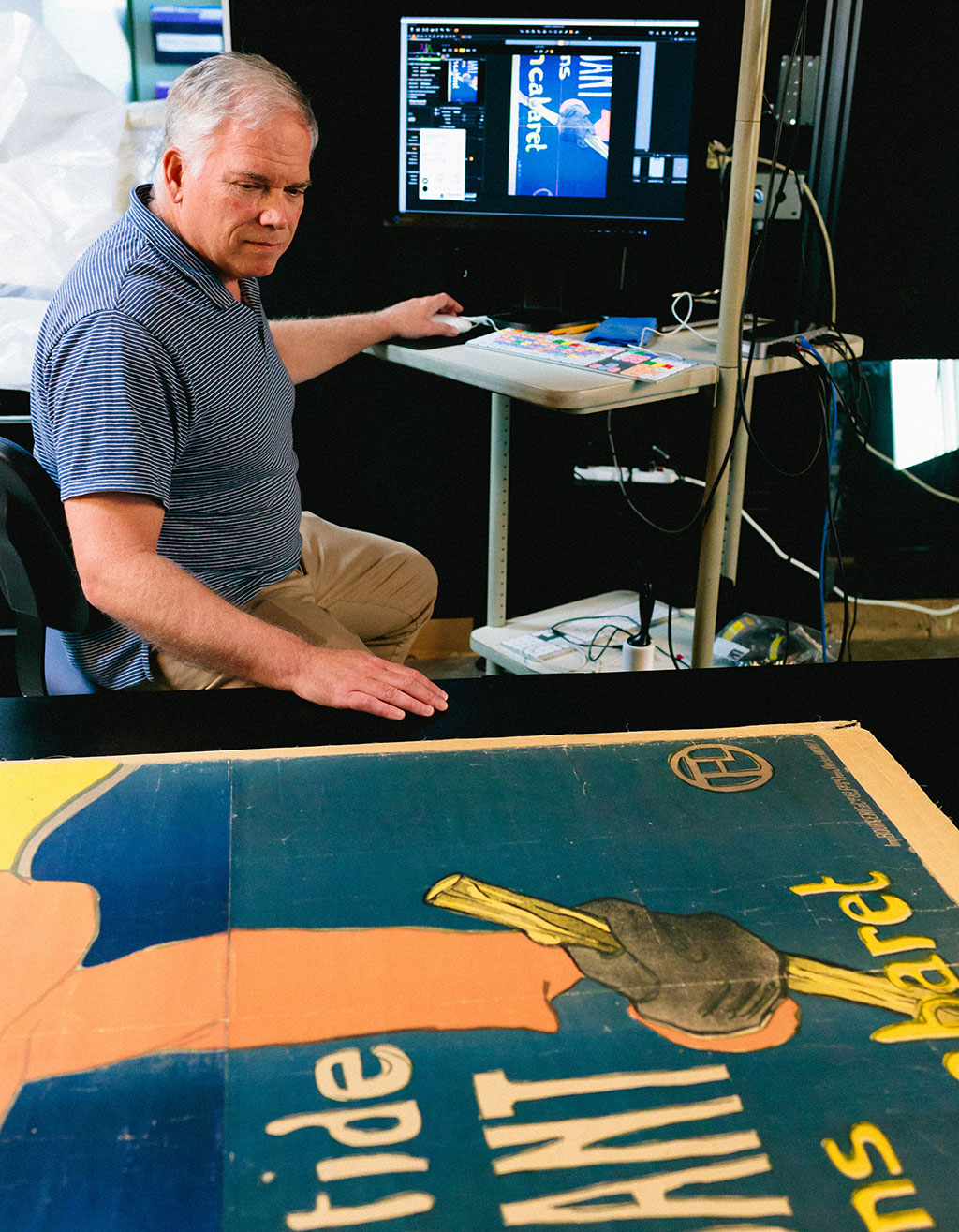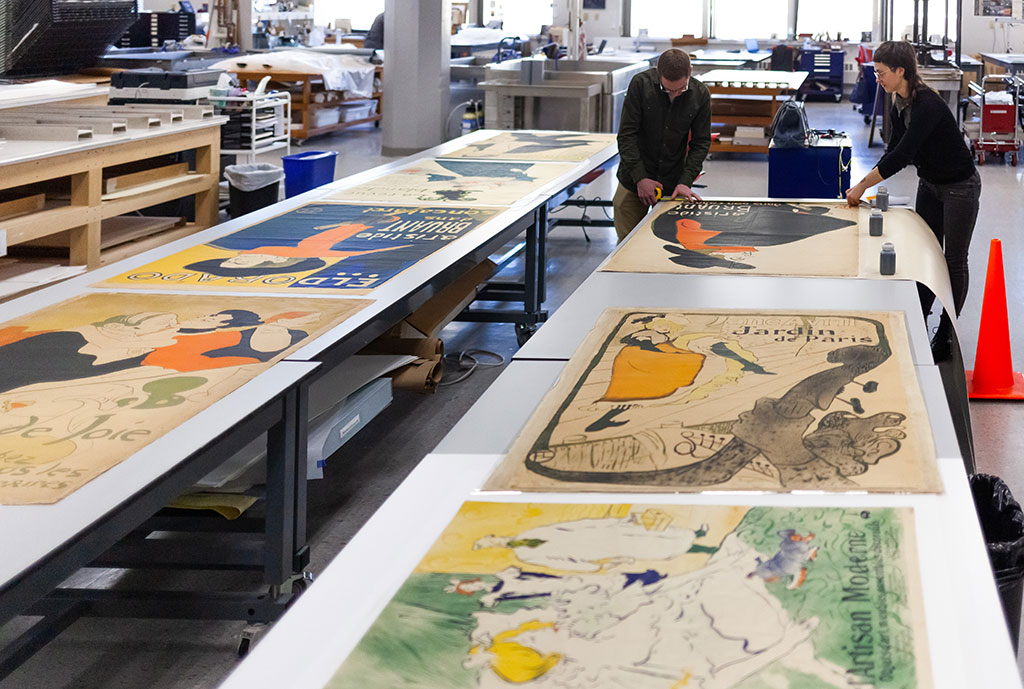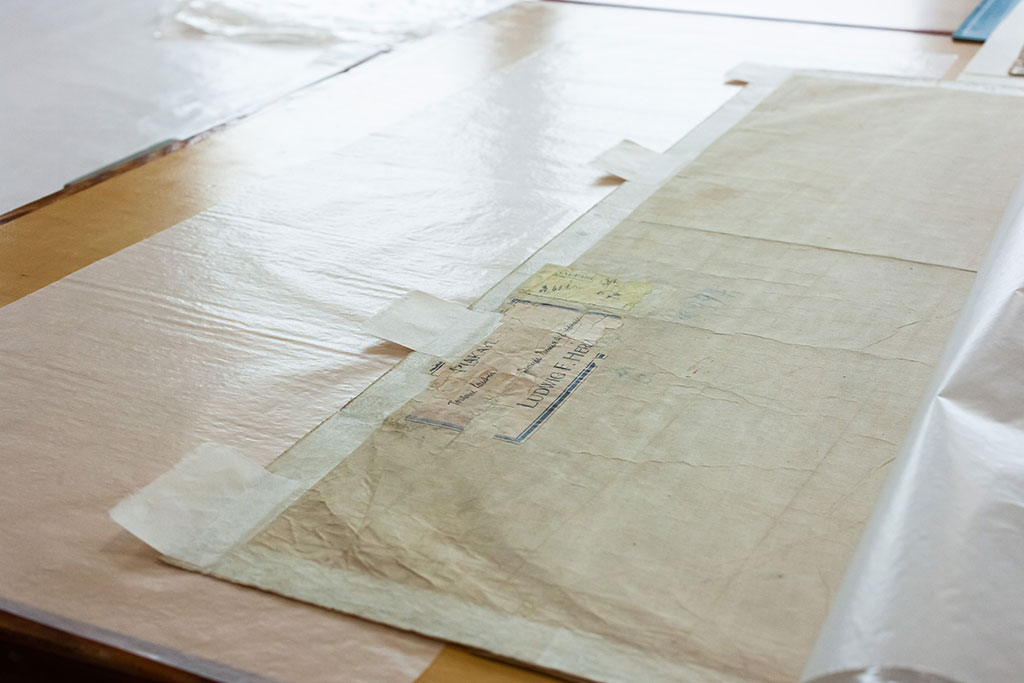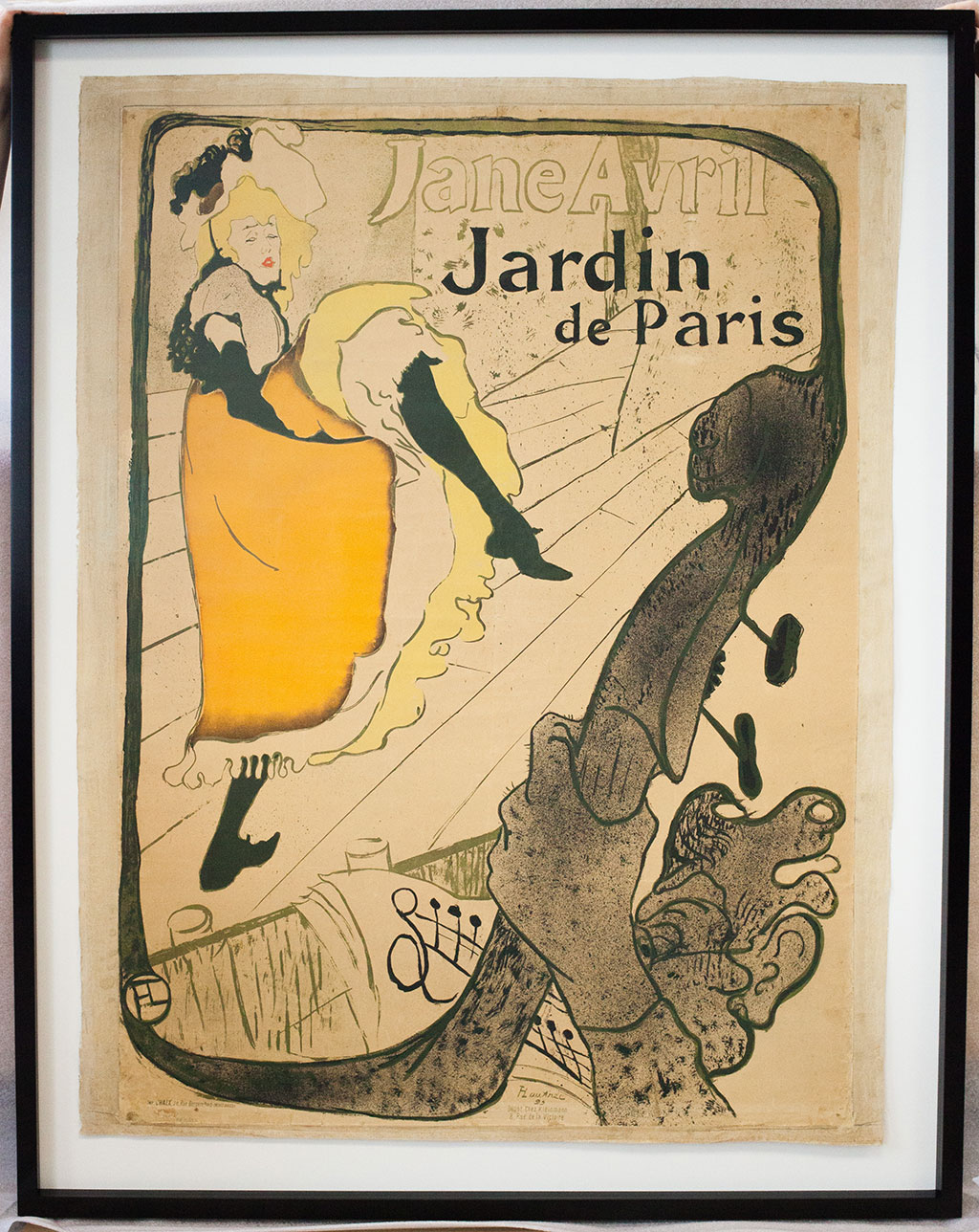Conservation Treatment and Digitization of Posters for Exhibit
by Terra Huber, Assistant Conservator, 2020
NEDCC conserved, digitized, and framed nine large Henri de Toulouse-Lautrec posters from the Boston Public Library’s collection in preparation for their loan for a major exhibition at the Museum of Fine Arts, Boston (MFA Boston) from April to August 2019. The treatment of these heavily damaged ephemeral objects, which are now revered as fine art, was a balance in subtle aesthetic improvement required for exhibition and structural stabilization for long-term preservation.
Toulouse-Lautrec and the Stars of Paris – The Exhibition
The exhibition of about 200 works by Henri de Toulouse-Lautrec and his contemporaries sought to capture the culture of fin de siècle Paris and its avant-garde celebrities as depicted by the artist most involved with the era’s raucous nightlife. Toulouse-Lautrec’s unique, expressive approach to mark-making, bright fields of color, and lively compositions were epitomized in the poster designs he created throughout the 1890s, elevating commercial lithographs from graphic design to fine art.
The MFA Boston’s show was a collaboration with the Boston Public Library (BPL), which loaned over 100 objects from its extensive Toulouse-Lautrec collection for exhibit. While the conservators at the MFA Boston prepared most of the objects for exhibition, nine posters needed more extensive conservation treatment, as well as digitization and framing. Five of the posters would be on display for the full four months of the exhibition at the MFA Boston, while the other four were to be shown one at a time over the four-month period in a case at the BPL Central Library. Funding for the posters’ conservation was underwritten by the MFA Boston and the Associates of the Boston Public Library.
Ephemera, Elevated
The budding advertising industry in the late 19th century called for quick and cheap ways to mass produce images for temporary display. These bold poster designs by Toulouse-Lautrec were commissioned by 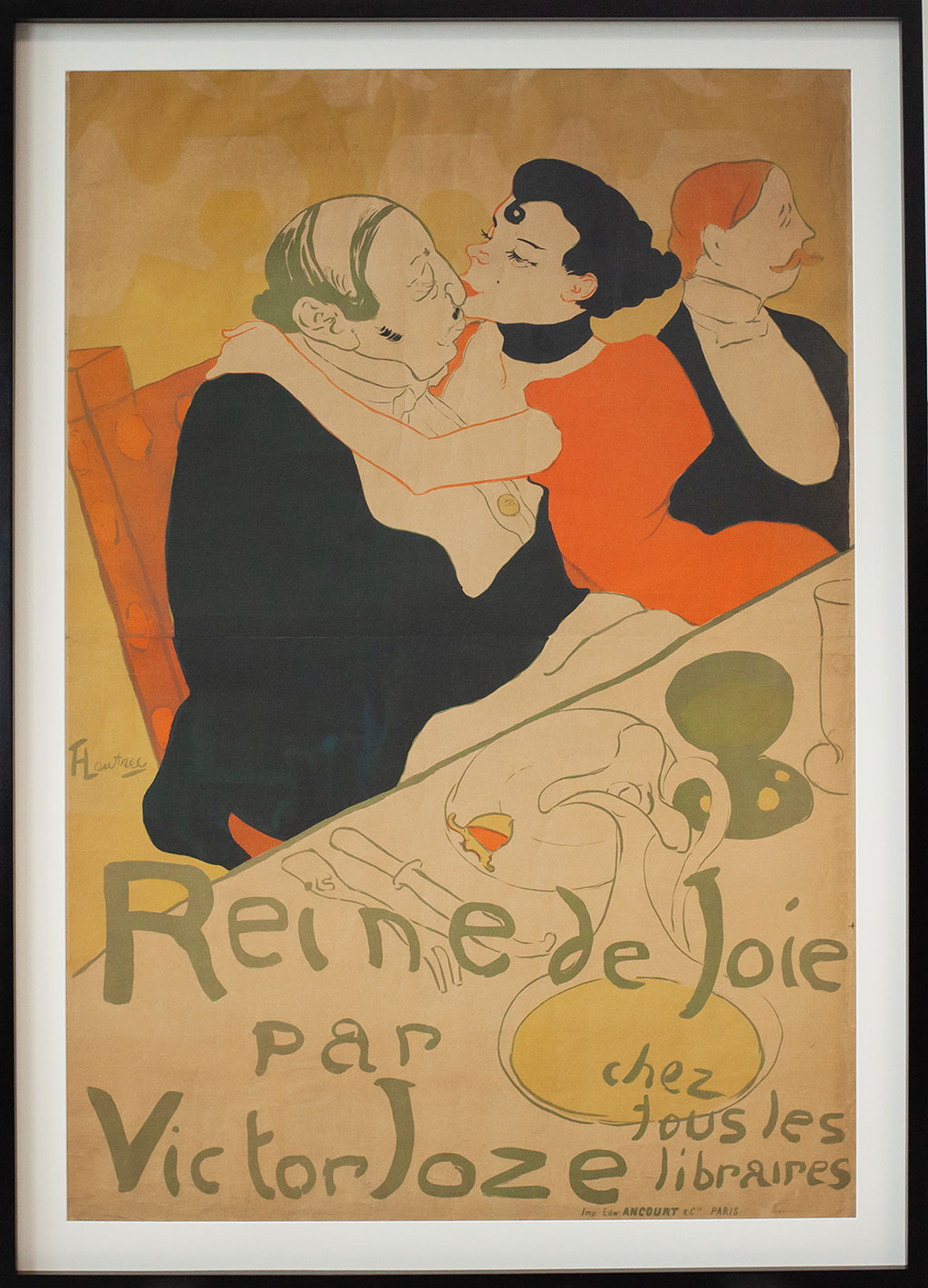 enterprises as diverse as nightclubs, publishers, and a cycling company to seize public attention and garner interest in events and products.
enterprises as diverse as nightclubs, publishers, and a cycling company to seize public attention and garner interest in events and products.
The posters were oversized to command attention, necessitating a large amount of paper. Costs could be cut by selecting inexpensive, low-quality paper that was thin and light enough to be quickly mounted with tacks or adhered to walls with paste. The advertisements were hung in densely populated and well-traveled locations, often outdoors, where they were subject to the damaging effects of the elements and vandalism.
These oversized posters on cheap, thin wood pulp paper were intended as commercial ephemeral objects and treated as such by those who produced and displayed them. However, Toulouse-Lautrec’s unconventional compositions and gestural lines combined with his sometimes suggestive subject matter created both sensation and scandal at the time of their display around Paris. Popular in their time, collectors quickly began to gather these posters that would likely have been discarded. Their value as images became much greater than the value of the materials used to create them and these ephemeral objects were elevated to fine art that must be preserved. Early collectors sought to extend the life of the degraded paper by lining the posters with textiles.
Project Planning Begins with Condition Assessment
An NEDCC paper conservator spent a day at the Boston Public Library carefully examining the condition of all nine posters and speaking extensively about the goals of treatment and the exhibition with BPL Curators and Preservation staff. The posters were then sent to NEDCC for further examination and testing, while treatment needs and goals continued to be discussed between NEDCC, the BPL, and the MFA Boston.
The nine lithographs were printed on the typical thin, low-quality poster paper of the time, which had become embrittled, discolored, and degraded. Each poster had been lined with a textile at some point in its history and tack holes with rust stains were visible along many of their margins. A surprising variety of textiles had been employed for this purpose, from very loose, open weave textiles to what appeared to be commercially prepared artist’s canvas with gesso. As a general rule, the more open the weave, the more tattered the edges of the lining and the paper support, and the worse the overall condition of the poster. The posters had all yellowed and darkened to differing degrees due to oxidation of what is likely the high lignin content of the low-quality paper support. Further probable causes of the paper discoloration include the lining adhesives and the degradation of the lining textiles. For the most part, the more visibly degraded the lining, the more discolored the paper support.

Prepared artist’s canvas lining with masking tape around edges
The linings had also caused damage when they were initially adhered to the posters. The lining adhesives introduced moisture to the paper support, causing the thin paper to expand when wet and then contract more than the textile did as it dried. This made some areas pull away from the textile and create wrinkles. As the paper aged and became more acidic, its thinness combined with its increased brittleness rendered it more and more delicate. Many of these posters were rolled, compressing these wrinkles until they tented further and the brittle paper cracked at the peak of each ridge. These raised areas were also vulnerable to abrasion, resulting in paper and media loss.
The edges of these oversized posters were crushed and ragged. Small pieces of paper around the heavily damaged edges detached from the poster but remained adhered to the lining, leaving complex channels of loss between them. Those pieces that remain attached to the open weave textile did so only tenuously and were extremely vulnerable to loss.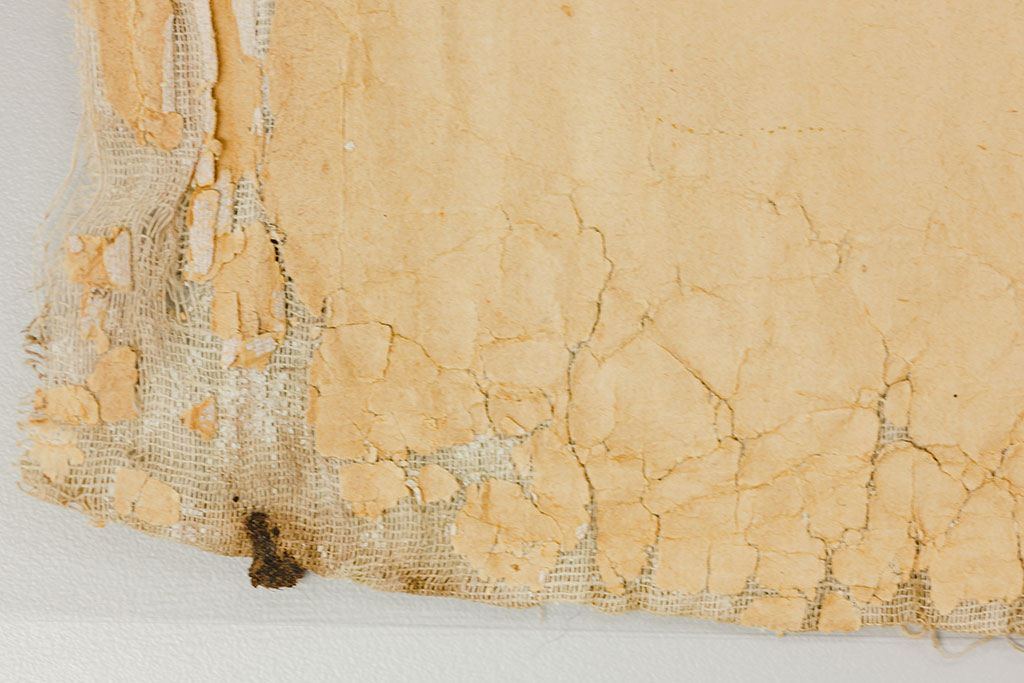
Tattered poster edges showing extensive loss and fragments detached from the whole
The poor condition of most of the posters necessitated extensive yet delicate conservation treatment to prepare them for exhibit and to stabilize them for long-term storage. The linings and size of the posters meant that they were heavy, especially those backed with gessoed canvas. Their weight and their extreme fragility posed a huge challenge for the structural stabilization required to mount and hang them vertically for a four-month exhibition. The treatment and framing goals were to ensure their safety for storage and protect them from further damage caused by handling, as well as increase their accessibility to the public and researchers.
Library and Museum: Different Mission, Different Goals
Discussions with the lending institution and the borrowing institution revealed some differences in how they envisioned the treatment of the posters should be performed. Although the ultimate goal of both institutions was to provide care that will preserve the posters for the long-term, the contrasting aesthetic approaches of a public library and fine art museum became apparent.
As the institutional owner of the posters, the Boston Public Library was interested in retaining as much visual evidence of the posters’ history as possible for researchers. This meant maintaining some marks of damage that would not threaten the preservation of the posters. It was decided that the tattered and vulnerable edges would be stabilized to protect the paper from further damage and to curtail the fraying of the lining textiles, but the edges would not be made perfectly straight and square. Only the most distracting paper losses would be filled, so a certain amount of the lining would still be visible from the front on some of the posters. The four posters to be on rotating display at BPL would be float mounted so the entirety of the edges could be viewed.
On the other hand, the Museum of Fine Arts, Boston intended to present the posters as fine art objects and were less focused on revealing traces of their history. The five posters to go on display at the MFA Boston would have losses filled using the same principles, but the tattered edges of the posters would be covered by mats. This was also necessary from a conservation point of view, as the over-matting would help to hold and stabilize the heavy posters over the four months of vertical display. Inpainting on all posters was only conducted on the most distracting media losses when standing at a normal viewing distance.
Conservation Treatment
Once the treatment plan was agreed upon, the condition of both sides of the posters was documented with digital images captured by NEDCC Collections Photographers. Three of the posters also had gallery stamps or provenance cards on their verso, which were also digitized with close-up images before treatment began.
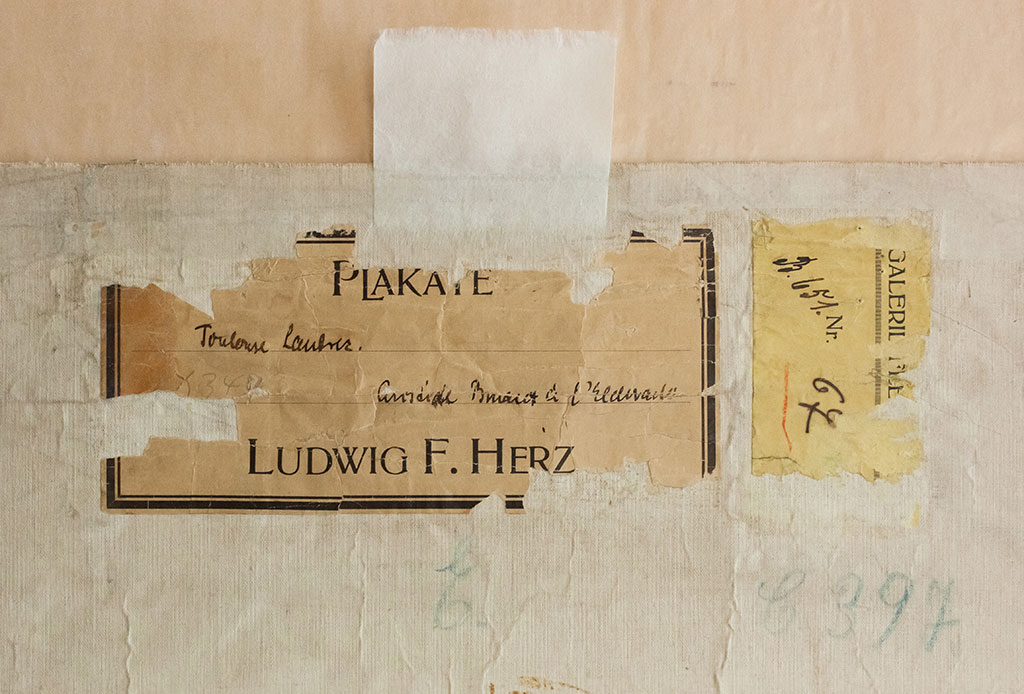
Provenance cards on the verso of a poster
The posters had accumulated dirt and grime from being displayed in public, outdoor spaces. The first step was to lightly remove loose dirt using soft sponges and brushes. Much embedded grime and soiling remains, as the degraded paper surface was very fragile and easily disturbed by abrasive action.
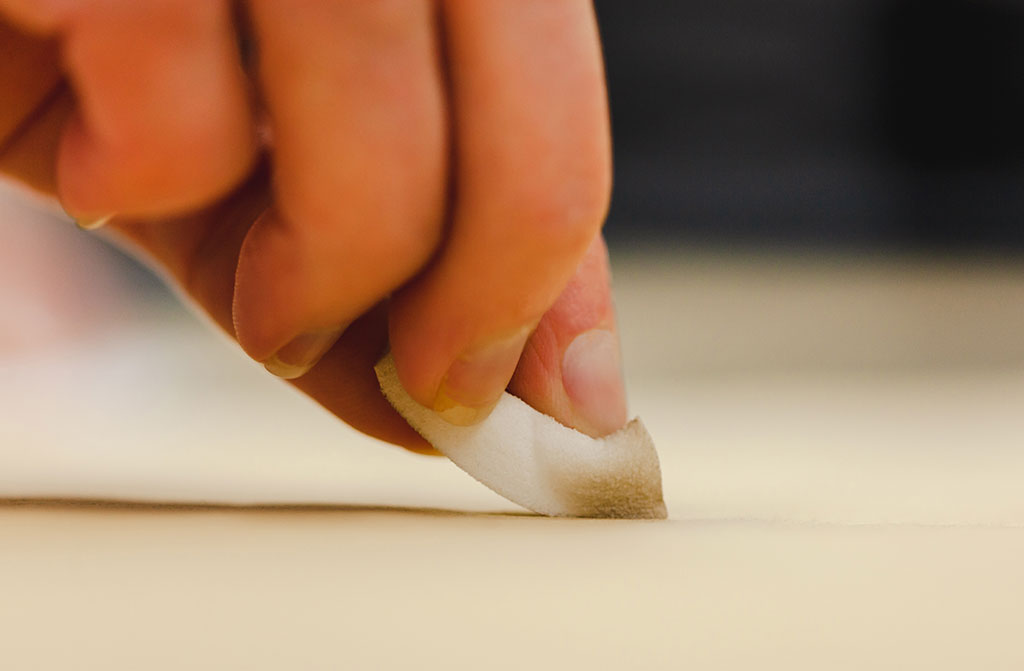
Surface cleaning the verso with a soft sponge
Lightly surface cleaning with a soft brush
All of the original lining textiles on the verso of the posters were kept due to the extreme fragility, thinness, and existing damage of the posters’ paper supports. Although the paper was tenuously adhered to the textile linings in many areas, wholesale mechanical separation of the brittle paper from the linings was impossible. Aqueous treatment was also not an option, as the paper formed dark stains and tidelines even when relatively low levels of moisture were introduced. Even if lining removal could be safely performed, the many small fragments at the edges of the paper would have been lost or damaged and the extensive cracking of the thin paper would increase and destroy the posters. Some of the textile linings had frayed edges, so that overhanging threads were trimmed to reduce the chance of further fraying.
Some of the posters had pressure sensitive tape, hinges, or self-adhesive labels that were removed mechanically or with small amounts of locally applied moisture. The adhesives were reduced mechanically or with organic solvents when possible.
Applying methyl cellulose under a detached split in the paper
Flattening the area
Due to the high risk of creating irretractable stains on the poster, consolidating, mending, and filling had to be accomplished using as little moisture as possible. To reattach the paper support where it had lifted from the lining and to prevent further loss where it had tented and split, methyl cellulose or dry wheat starch paste were applied through the looser weave textiles from the verso or were deposited through the cracks in the paper support. Some splits and tears were strengthened from the verso with Japanese kozo tissue and dry wheat starch paste. One smaller poster was supported using a low moisture lining technique with Japanese kozo tissue and reactivated wheat starch paste and methyl cellulose. The edge of two of the most heavily damaged posters were reinforced using the same technique with strips of kozo.
Strip lining the edge of a poster with re-moistenable Japanese tissue
The crushed areas along the edges of the posters had a tremendous amount of irregularly-shaped loss between small pieces of remaining paper support. In order to visually integrate these losses without introducing excessive moisture or overlapping the original material, a slurry of cellulose powder and methyl cellulose was applied to the gaps with a microspatula. The color of the cellulose powder was first modified to a light brown to match the original paper tone. In several places, a more typical filling method was applied using cast paper and methyl cellulose or dry wheat starch paste, but this was only done where the fills could be adhered behind original material or with an extremely small overlap.
Applying a cellulose powder and methyl cellulose slurry to edge losses
Two different colors of cellulose powder
Media loss was present throughout the posters where the paper support had cracked or torn, had been abraded, or was lost. Some losses in image areas had been filled with white or colored paper in the past and a number of these areas included poorly executed inpainting. Fills that were applied to the recto of the poster were removed and inpainting was reduced with a small amount of locally applied moisture. Losses in the printed media were then visually unified with the poster through inpainting. An isolating layer was first applied locally to the loss areas so the inpainting media would not be absorbed into the damaged fibers and become difficult to reverse in the future if needed. As per discussions with the BPL and the MFA Boston, only losses that were distracting from a typical viewing distance of several feet were compensated so as to not obscure traces of the posters’ history.
Removing an oversized colored paper fill
Inpainting with watercolors
Posters that retained undulations from rolled storage or original linings were slowly humidified in a moisture chamber and allow to dry while flattened between felts under acrylic sheets and weights. This process was repeated as necessary until planar distortions were adequately reduced for matting and framing.
Lifting poster off of humidification packet and onto flattening table
Rolling the top felt on for drying, and readying Plexiglas for flattening
Digitization
The Toulouse-Lautrec posters conserved at NEDCC were also digitized at preservation quality. In general, the posters were digitized following the vast majority of their conservation treatment but prior to matting and framing.
Two posters, Eldorado Aristide Bruant and Aristide Bruant dans son Cabaret, were selected by BPL staff for preservation quality imaging before and during treatment as well. The goal behind these additional rounds of digitization was to create high quality images that could document the nuance of the conservation treatments performed and thus be used in the Library’s educational programming. In tandem with each poster displayed at the Central Library, the BPL featured information and images on the conservation process in action to build awareness and support for this important work.
The two posters selected for additional imaging were captured before any treatment started, documenting the full extent of damage suffered by the posters. For the ‘during treatment’ imaging, the collections photographer worked closely with the conservators to determine the stage of each poster’s treatment that would be most illustrative of the impact of the treatment. The conservators chose to have the posters imaged following cleaning, initial flattening, mending, and filling losses but prior to in-painting and the more intensive flattening campaign that came at the end of treatment. Captured at this stage, the images make clear the painstaking work involved in the conservation treatment and some of the aesthetic improvement such treatment yields.
Detail: Eldorado Aristide Bruant poster Before Treatment
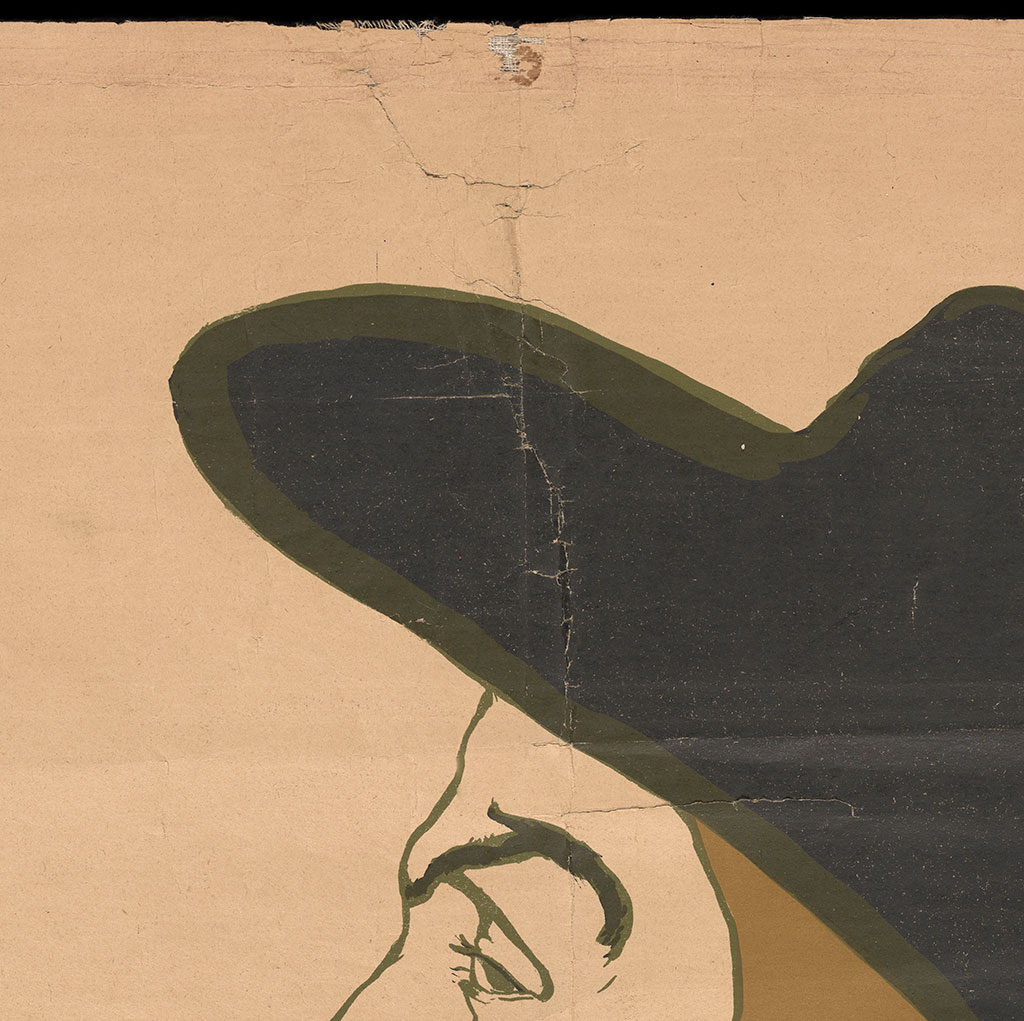
Detail: Eldorado Aristide Bruant poster During Treatment
Detail: Eldorado Aristide Bruant poster After Treatment
The digitization process itself took place on NEDCC’s X-Y table, which is used for digitizing large format materials. The X-Y table is a 4’ x 8’ vacuum table on rails, with a medium format digital camera suspended above. When digitizing large objects at high resolutions using digital cameras, the camera can only capture a portion of the object at a time. This is where the X-Y table comes in. Because the table is on rails, the posters were placed on the table and then the table was moved along its X and Y axes underneath the stationary camera as overlapping sections of the posters were captured in a series of separate image files. The largest of the Toulouse-Lautrec posters required 12 separate image files, each more than 11,000 pixels on their long dimension and larger than 600 MB.
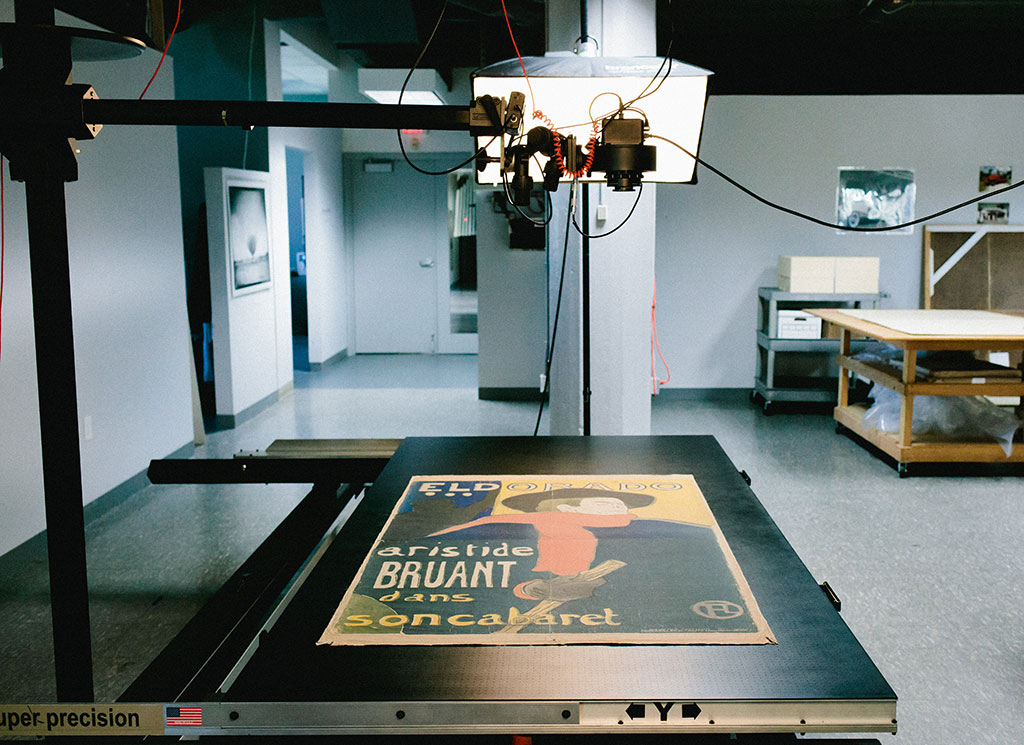
Digitization set-up on NEDCC's X-Y table
After the overlapping image files were captured, they were ‘stitched’ together in commercial image editing software to create single high-resolution images representing the posters in their entirety. After years of imaging large format materials, the NEDCC collection photographers have learned that stitching image files together often requires some helpful strategies to achieve good results. For example, magazine clippings were placed around the perimeter of posters that had large areas of homogenous visual content. The magazine clippings gave the stitching software unique visual information to match from image segment to image segment, and yielded more accurately stitched images for those otherwise challenging to stitch posters.
But even when the series of files captured from a poster appeared to have assembled together seamlessly, the resulting image had to be inspected at full magnification along all of the seams to ensure there was no mis-registration from one segment to the next. If any mis-registration was identified, this would require either that segment files be stitched together manually, or that the segment files be re-captured with greater overlap from section to section.
Aristide Bruant dans son Cabaret poster with seams highlighted in the software, illustrating the relationship of the 9 separate image files required to capture the poster in its entirety.
The posters presented some unique challenges for digitization even beyond their large format. Most notable were the planar undulations described above. Even though the posters were humidified and flattened for weeks prior to imaging, some planar distortion simply could not be eliminated. We often encounter objects with such subtle topography, and rarely does that topography impact image quality. However, several of the posters had large swaths of dark color printed on very smooth papers (Eldorado Aristide Bruant is an excellent example), and under these circumstances the subtle undulations would receive and reflect more light than adjacent, flatter areas of the poster. In the digital images, this resulted in a mottled appearance not accurate to the experience of viewing the posters in person. With some creative lighting, both softening the light and adjusting its angle and position relative to the posters, the photographer was able to minimize the hard reflections generated by the surface topography and thus achieve images much more truly representative of the posters themselves.
Mounting and Framing
Following digitization, the posters were ready for mounting and framing. The posters were first attached to a 100% cotton rag backing board with Japanese paper hinges adhered with wheat starch paste on the object, a bead of wheat starch paste and Jade 711 (a synthetic adhesive that improves attachment) mixture at the fold, and Jade 711 on the backing board. For the four posters to be displayed at the BPL, the hinges were not visible and the objects were float mounted within the window opening. For the five posters to be displayed at the MFA Boston, the objects were over-matted and all edges were covered. All posters were placed in custom-made stained wooden frames with wooden strainers and 4.5mm Optium Museum Acrylic for glazing. A Tycore mounting panel was placed behind the backing board to provide additional support and aluminum channel fillets were used to keep the object from coming into contact with the acrylic glazing.
Measuring the posters for matting and framing
Japanese kozo hinges attached along an upper edge
Jane Avril float mounted for display at the Boston Public Library, oversized lining textile visible

Caudieux, over-matted for display at the Museum of Fine Arts, Boston
Conclusion
The treatment approach to these Toulouse-Lautrec posters was focused on structurally stabilizing the fragile materials in order to allow them to be safely exhibited for a number of months and stored in the future. The interventions were as non-invasive as possible, using materials and methods that do not alter or obscure the original material of the object and can be reversed by future conservators if further treatment must be performed.
The posters have been preserved while also making them available for the public. Their frames will help protect them from further damage caused by handling these large and fragile posters.
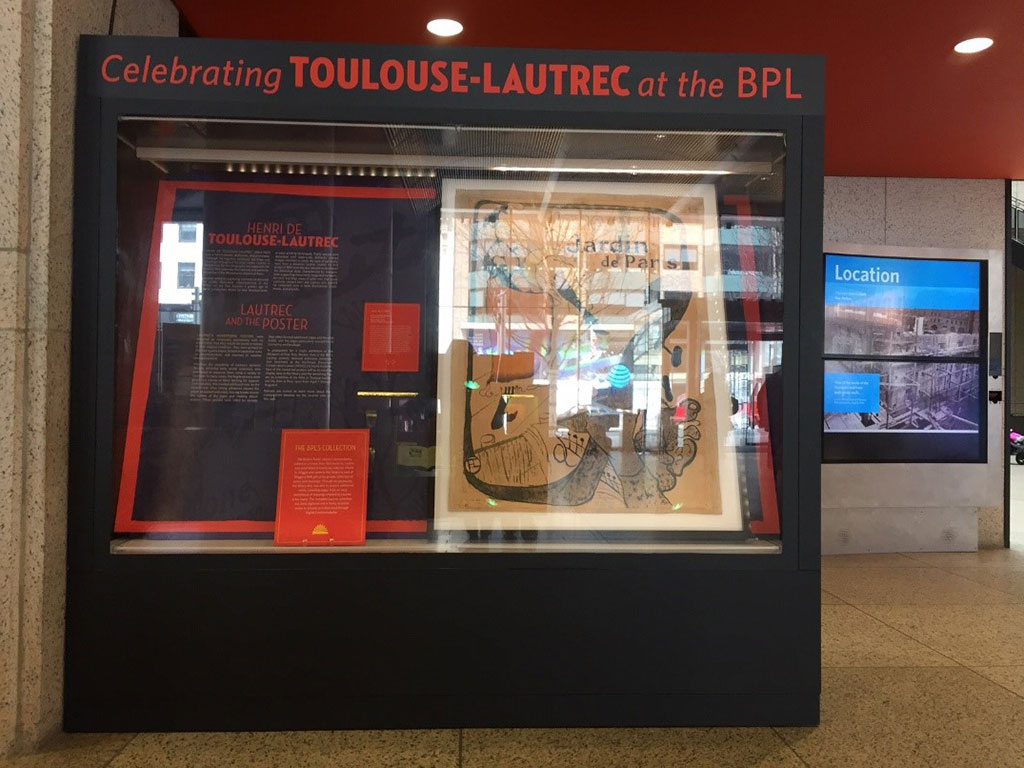
Rotating poster display at the Boston Public Library
LEARN MORE
ABOUT the Boston Public Library
Boston Public Library provides educational, cultural and civic enrichment, free to all, for the residents of Boston, Massachusetts and beyond, through its collections, services, programs, and spaces. Established in 1848, the Boston Public Library is a pioneer of public library service in America. It was the first large free municipal library in the United States, the first public library to lend books, the first to have a branch library, and the first to have a children’s room. Boston Public Library today features the Central Library in Copley Square, twenty-five branches, and extensive special collections of rare books, manuscripts, maps, photographs, prints, digital content, and online services. To learn more, visit bpl.org
Visit the complete Henri de Toulouse-Lautrec (1864-1901) Prints and Drawings collection at the BPL.
ABOUT the Museum of Fine Arts Boston
MFA is one of the most comprehensive art museums in the world; the collection encompasses nearly 500,000 works of art, and welcomes more than one million visitors each year to experience art from ancient Egyptian to contemporary, special exhibitions, and innovative educational programs. To learn more, visit mfa.org
ABOUT Toulouse-Lautrec’s and Paris in the 1890s
Courtesy of Museum of Fine Arts Boston
View the MFA’s “Welcome to 1890s Paris Nightlife.” The video presents an effervescent time in the French capital, when artists captured a celebrity-mad Paris in posters, prints, drawings, and paintings.
View the MFA’s “Hear from the Curator” a video introducing us to the city's glitterati and describes the convergence of celebrity culture and a new medium—the lithograph—finding its perfect expression through the art of Lautrec.
NEDCC Project Team:
The treating conservators on this project were Terra Huber, Suzanne Gramly, Audrey Jawando, Amanda Maloney, Natalia Paskova. Senior Collections Photographer David Joyall provided digital imaging. Jonathan Goodrich, NEDCC registrar, made sure they were safely packed and shipped. Director of Imaging Services Terrance D'Ambrosio provided the description of the digitization process.
Thanks to BPL Preservation Manager Jessica Bitely for her help with the story.
Story by Terra Huber, Assistant Conservator, 2020



